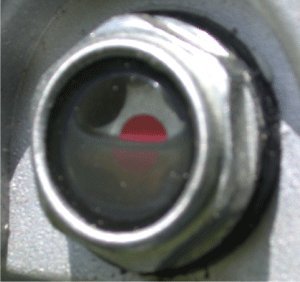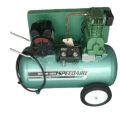Hey! This site is reader-supported and we earn commissions if you purchase products from retailers after clicking on a link from our site.
How do you change air compressor oil? On this page, I will provide as much of a step-by-step process for you as I can. The process of changing compressor oil is normally not so difficult. It can, however, be really messy if you are not very careful!
Though all oil-lubricated compressors from different compressor manufacturers may have slightly different oil change processes, the overall concepts presented on this page will work for all oil-lubricated compressors.
Table of Contents
- Changing the Air Compressor Oil
- How Often Should I Change Air Compressor Oil?
- What Type of Oil in the Compressor?
- Does Your Air Compressor Need Oil?
- FAQs (Frequently Asked Questions)
Changing the Air Compressor Oil
Let’s get down to the process of actually changing your air compressor oil, with the following simplified steps:
Time needed: 30 minutes
Changing Air Compressor Oil – Time Estimate: 5 minutes + amount of time needed to warm compressor
- Allow Compressor to Warm
Like a car engine, the oil in the compressor will run easier if it’s warm. Leave the compressor sitting in the sun for a while before you start the job, or let it run and fill the air tank before you start.
- Open Fill Port
Open the fill port to allow air to flow more easily down into the sump.
- Position Funnel
Position your drain catchment/funnel or whatever you’re using to help contain the oil, and carefully open the drain plug. You want the oil warm, but it might be quite hot, so take care.
- Lift Compressor
My compressor has a handle on the front, so when the oil stops flowing out of the drain port, I lift the front of the compressor to help void the sump of any residual oil.
- Replace Drain Plug
Replace the drain plug, and wipe any oil residue from the surface so that you can see if you have a leak.
- Pour in Replacement Oil
Pour fresh compressor oil into the fill port to the specified level for your compressor.
- Replace Oil Fill Cap
Replace the oil fill cap and you’re good to go!
Below is an image of a typical DIY air compressor, focusing on the compressor head, and the 4 components you will need to identify on your compressor for when it comes to an oil change.

Now you must ask, what exactly are these components?
- Oil Fill Port
- Sight Glass
- Oil Sump
- Drain Plug
So let’s take a look at these 4 components in greater detail.
Oil Fill Port
Item #1 in the photo is the oil fill port for the compressor. It makes sense for it to be located on your compressor at a higher level than the oil drain port.
However, not every compressor is the same, yet all oil-lubricated units will have an oil fill port of some sort. This port will allow oil to be poured into your compressor to flow down to enter the oil sump located under the piston head assembly.
I’d recommend keeping a small funnel handy when you go to pour the oil back in. Otherwise, you may cause yourself a bit of a mess by spilling the oil as you pour. This is the voice of experience!
Normally, the cover for the oil fill port is vented, and for good reason. Your air compressor consumes a little, or sometimes a lot, of oil as it runs. If the port was not ventilated, eventually, a vacuum would form in the sump, which would then limit the efficiency of the lubrication process.
Sight Glass
Item #2 in the photo and on my compressor is a sight glass that will allow you to peer into the oil reservoir to see how full (or empty) the oil level is. On this compressor, and typically on others with a sight glass like this one, the recommendation is to keep the oil full to the center of the red dot.

Your compressor, too, must have some method of determining how much oil you need to add to top up your compressor sump. If not a sight glass like the one in the photo above, then the cap of your oil fill port may also contain a dipstick.
Other compressors have no sight glass or dipstick. Folks generally add oil to the bottom thread of the oil fill plug on these types.
Overfilling the oil sump will lead to maintenance issues for your compressor, so it is important to avoid that if possible. If overfilled with oil, drain some out before powering on the compressor.
You must keep the oil level topped up (the cheaper the oil-lubed compressor, the more oil it uses, it seems) and you must not overfill it.
The Oil Sump
Item #3 in the photo above points to the compressor casing, inside of which is the oil sump.
The bigger the compressor, of course, the more oil it will need. One like the typical one presented will only hold a few ounces, so it’s important to take real good care not to overfill.
At the same time, the oil level should be checked every time you go to turn the compressor on, as it doesn’t take long for it to go through those few ounces of oil.
Drain Plug
Item #4 in the photo above is the drain plug. Removing this plug will allow the oil to flow out of the sump.
Some compressors (typically the more expensive ones) actually have an extension on the drain port to allow the easier collection of the oil.
Unless you are really careful, you will drip dirty oil all over everything. So pick your spot or layout something beneath the drain, one that won’t be damaged by oil leaking onto it in the case that you have a spill.
Now, drain the oil out into a reservoir or similar to contain the mess.
Draining the compressor oil can get really messy if you don’t contain the flow of the used oil inside, and it can be very difficult to clean up. So please take great care!
How Often Should I Change Air Compressor Oil?
It is recommended by your compressor manual that you change the compressor oil regularly as you do in your car.
For the DIY type air compressor user, unless you are using it all the time, follow the manual guidelines or change the oil every 6-12 months.
If it is an industrial air compressor being used continuously, depending on the model of your air compressor and the manufacturer’s recommendations, consider changing the oil every 300 hours of compressor operation.
What Type of Oil in the Compressor?
What oil do you use in your compressor? A general rule about what compressor oil to use is quite simple if your air compressor is under warranty, I use the oil that is recommended by the manufacturer and should be noted in the compressor manual. (There’s plenty of discussion and debate about selecting an oil of your preference over at Garage Journal)
If the warranty period for the air compressor has passed then you should buy lubricating oil from a hardware store or through Amazon!
I’d say this rule applies to home DIY compressors only. Some of the more sophisticated and larger compressors – rotary screw, vane, etc. – used by the industry have very specific requirements for oil. You must use the oil recommended by that compressor manufacturer or you void the warranty or cause oil-related issues.
For more information on what type of oil you should use in your air compressor, visit our Air Compressor Oil Types GUIDE!
Air Compressor Oil Substitutes
Ideally, you should not use any other type of oil in your air compressor except oil that is clearly labeled as air compressor lubricating oil.
Air compressor oil has the proper additives to make it suitable for the harsh, compressor lubricating environment. These additives are not necessarily found in automobile oil, air tool oil, etc.
The additives that are other types of oils are not compatible and, in fact, may damage your air compressor. If it does not say compressor lubricating oil on the package, don’t put it in your compressor.
However, if you are desperate then please visit our Air Compressor Oil Substitute – Alternatives Compared page in order to ensure you pick out the most suitable substitute!
Does Your Air Compressor Need Oil?
First of all, and I know this may sound a bit silly, but it is a mistake easily made as not all air compressors are oil lubricated.
In fact, a lot of the little DIY type air compressors now available from the big box stores are added-lubrication oil-free. They are factory lubed for life, so you cannot change the compressor oil in these compressors because there isn’t any to change, to begin with.
You must ensure you have adequate filters and oil separators within the air compressor system to ensure you abide by OSHA regulations,
For more information on Oilless Air Compressors vs. Oil Compressors please visit our guide!
FAQs (Frequently Asked Questions)
When the compressor is running, depending on the size and type of air compressor, the oil will either splash up from the sump into the areas that require lubricating, or there will be an integral pump to pump the oil from the sump up to the parts needing continuous lubrication while the compressor is running.
The typical DIY type oil-lubricated home compressor will be the splash lubed variety. If it is splash lubed there will be no extraneous oil pump on the compressor, meaning there is none to maintain or replace. If your compressor is designed to be splash lubed, that process works just fine.
Oil-lubricated compressors have an oil sump similar in concept to those in an automobile. It will have an oil pan.
Lubricating oil that is added to the compressor flows down into the oil sump and sits there, under the pump, waiting for the compressor to start.
Additional oil reading:
- Air Compressor Oil Capacity Guide – Air Compressor Oil Levels
- Air Compressor Oil Types GUIDE – What Oil to Use in Air Compressor
- Air Compressor Oil Sight Glass – Oil Level Sight Glass Guide, Replacing & Reading
- Air Compressor Oil Related Issues – Oil Damage To Compressors
- Air Tool Oil Substitutes And Alternatives
- Air Compressor Oil Substitute – Alternatives Compared
- Oilless Air Compressors vs Oil Compressors – Differences Between Oil and Oil Free Air Compressors
- 10 Best Air Tool Oils
- 10 Best Oil Free Air Compressors
- How to Quiet An Oilless Air Compressor
- Air Over Oil – Air Over Hydraulic Cylinder Benefits & Uses
- Air Compressor Oil Breather / Crankcase Breather Cap Buying Guide
- Air Compressor Oil Separator Guide – Air Oil Separators & Oil Water Separators
- What Happens if an Air Compressor Runs Out of Oil?
- Air Comes Out of the Oil Fill Cap
- Compressor Has an Oil Issue
- Oil in compressor tank drain water
- Why air coming from our compressor has bad smell same as burned oil
- Why does oil come out of the oil fill tube?
If you have any questions regarding changing your air compressor oil, please leave a comment below, with a photo if applicable, so that someone can help you!





